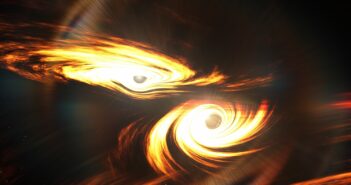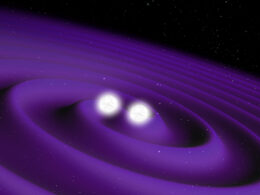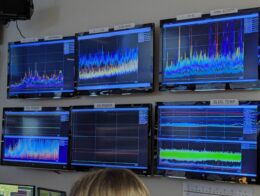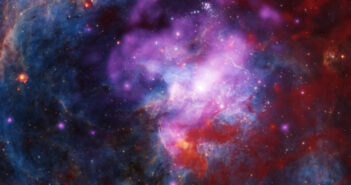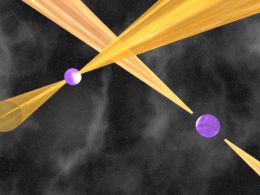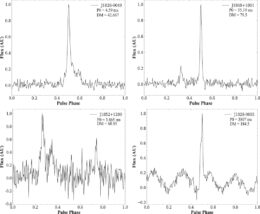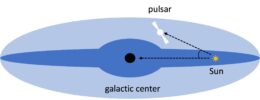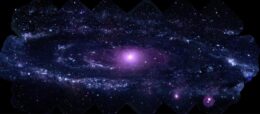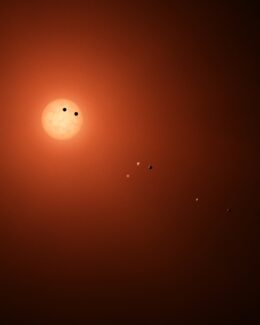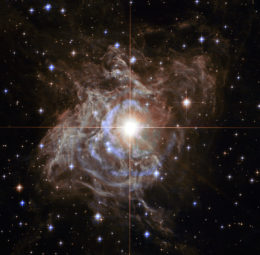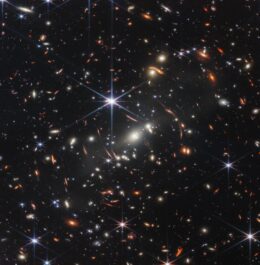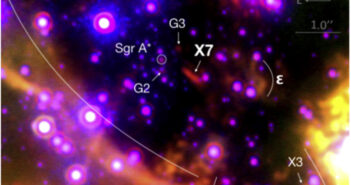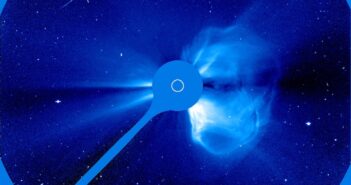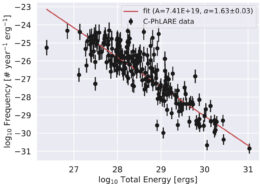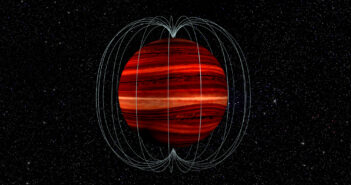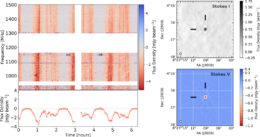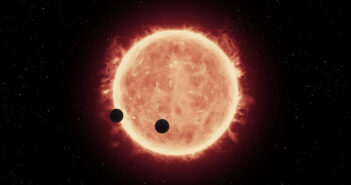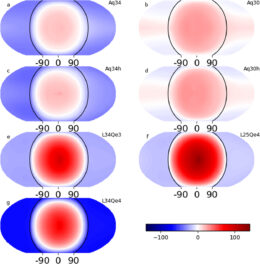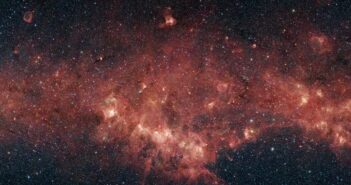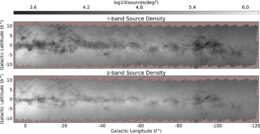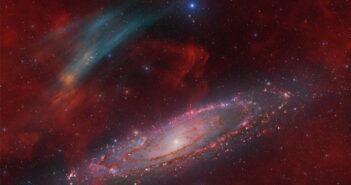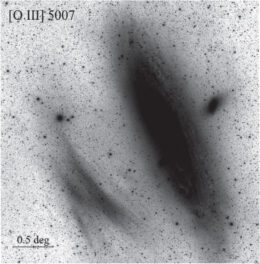This was a year of superlatives in astronomy — researchers studied the brightest known gamma-ray burst, modeled the strongest material in the universe, and announced the finding of the first compelling evidence for the gravitational wave background. As 2023 draws to a close, let’s take a look back at some of the amazing science we covered on AAS Nova this year. Here are the top 10 most-read posts of 2023:
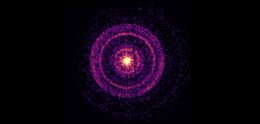
An X-ray image of GRB 221009A’s emission scattering off of dust. [Adapted from Williams et al. 2023]
The gamma-ray burst GRB 221009A exploded onto the scene in October 2022 and earned the moniker the BOAT — Brightest Of All Time. A Focus Issue of the
Astrophysical Journal Letters highlighted the multifaceted, multinational, and multi-wavelength efforts to study this burst, including the hunt for an accompanying supernova, the search for neutrinos produced during the burst, and an assessment of whether GRB 221009A truly deserves its nickname.

Artist’s impression of a neutron star, the core of a massive star that has exploded as a supernova. [ESO/L. Calçada; CC BY 4.0]
The crystalline crust of a neutron star is the strongest material in the universe, and its extreme strength and density pose a challenge for modelers. Using a smoothed-particle hydrodynamics code tuned to include material strength, Irina Sagert and collaborators modeled waves in a neutron star’s crust. These waves might explain some properties of neutron star X-ray flares, and they may have an impact on the gravitational waves produced as neutron stars spiral toward a collision.
Dark energy is thought to be responsible for the accelerating expansion of the universe. David Benisty, Anne-Christine Davis, and Wyn Evans measured the influence of dark energy in an entirely new way by modeling the orbits of the Milky Way and our neighboring galaxy, Andromeda. This method takes into account the outward pressure that dark energy exerts on the two galaxies as they slowly orbit one another. While the constraint placed by this method isn’t yet particularly stringent, the result agrees with measurements made on much larger scales, and upcoming data should allow the team to refine their results.
In the first entry in the new Monthly Roundup series, we examined five research articles that tackled recent JWST observations of the TRAPPIST-1 system. The M-dwarf star TRAPPIST-1 became a household name when seven Earth-size planets were discovered in orbit around it. This large number of Earth-like, potentially habitable planets — as many as four of the seven may lie in the star’s habitable zone — makes TRAPPIST-1 a tempting target for atmospheric characterization, which is a challenge even for JWST’s gigantic mirror and sensitive instruments. The articles describe studies of JWST spectra of the innermost two planets, modeling of the possible atmospheres of the outer planets, and an exploration into whether we’d be able to detect life on these planets at all, if it exists.
Cepheid variable stars provide a powerful way to measure the distances to other galaxies. These stars vary in brightness in a predictable way, and how quickly their brightness varies is linked to their intrinsic luminosity. This method has been used to measure the rate of expansion of our universe, but the result disagrees with the value measured through other means, raising a long-standing problem dubbed the “Hubble tension.” Researchers plan to re-observe the Cepheid variable stars previously observed with the Hubble Space Telescope, in the hopes that JWST’s superior infrared capabilities can ease this tension — an effort that will take years. Wenlong Yuan and collaborators got a sneak preview of JWST’s abilities when the telescope observed a galaxy containing multiple Cepheids.
The first JWST image seen by the public was of the spectacular galaxy cluster SMACS J0723.3–7327 (SMACS 0723). In the months following, astronomers studied the image from every possible angle, examining the structure of the cluster itself as well as the faint, distant galaxies whose light was curved into our line of sight by the cluster. This article introduced five research articles that advanced our understanding of the SMACS 0723 field, including weighing the galaxy cluster, investigating individual star clusters billions of light-years away, and measuring the chemical makeup of distant galaxies.
Have you ever wondered where all the dust in the universe comes from? Megan Peatt’s team investigated the dust production in a rare binary system composed of a Wolf–Rayet star — a massive star that has lost its entire hydrogen envelope, leaving behind a scorching hot core wreathed in shells of gas — and an O-type star rotating so fast that it’s losing its grip on its atmosphere. Each time these stars get close, the collision of the Wolf–Rayet star’s fierce stellar winds with the O star’s decretion disk produces dust. The stars are scheduled for their next close approach in 2024, and astronomers have seized the opportunity to collect infrared measurements of the pair that reveal the amount and type of dust being created as production ramps up.
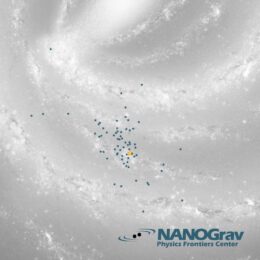
Locations of pulsars (blue stars) in the NANOGrav pulsar timing array relative to the location of the Sun (yellow star). Some pulsar locations are approximate. Click to enlarge. [NANOGrav]
Using a closely monitored collection of rapidly spinning stellar remnants called pulsars, multiple international collaborations including the North American Nanohertz Observatory for Gravitational Waves, or NANOGrav, announced their discovery of compelling evidence for the long-sought-after gravitational wave background. This background signal, which is too low in frequency to be detected by gravitational wave observatories on Earth, is thought to be the rumblings of supermassive black hole binaries. The exact source of the gravitational wave background remains undecided, though, and more observations and modeling are needed to rule out the possibility that this background signal is the result of new physics.
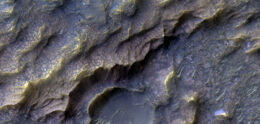
The “dragon scale” texture seen in this Mars Reconnaissance Orbiter image of Mars’s surface is the result of water interacting with bedrock, forming clay-containing rock. [NASA/JPL-Caltech/UArizona]
The presence of persistent liquid water on Mars is a matter of intense debate —
it even merited its own round-table discussion at this year’s Division for Planetary Sciences meeting. Recently, laboratory experiments led by Andrew Shumway demonstrated that whether or not water is briny (i.e., salty, in the chemical sense) and mixed with Martian surface material, or regolith, plays a huge role in the conditions under which water remains a liquid. Briny water that seeps into regolith can remain a liquid under colder and drier conditions than pure water alone, suggesting that water could be more widespread on Mars than previously thought.
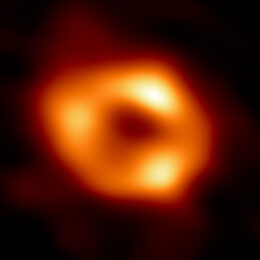
The first image of the supermassive black hole at the center of our galaxy, constructed from data from the Event Horizon Telescope. [EHT Collaboration]
The most-read article on AAS Nova in 2023 linked two hot topics in astronomy: black holes and dark energy. Duncan Farrah and collaborators found that the supermassive black holes at the centers of galaxies across the universe are growing too quickly than could be accounted for by their galaxies’ supplies of gas and dust. Instead, Farrah’s team proposed that the growth of these black holes is linked to the expansion of the universe — a property belonging to a theorized type of black hole filled with vacuum energy. The expansion-linked growth of these black holes produces outward pressure that accelerates the expansion of the universe or, in other words, produces dark energy.
Thank you for joining us for another year of great science — we can’t wait to see the discoveries that 2024 will bring!
